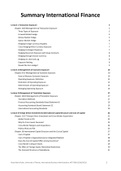Summary
Summary International Finance
- Course
- Institution
The summary of International Finance is an extensive summary which includes chapters of the customer book and the slides provided during the lectures. The chapter summarized are 14 until 20 (of the custom book). The information from the slides is already added in the content of the summary. So ther...
[Show more]



